Paper probes pulsar pair
April
30: The only known gravitationally bound pair of pulsars—extremely
dense, spinning stars that beam radio waves—may be pirouetting around each
other in an intricate dance.
 FULL STORY FULL STORY
 |  |

|
 |
Hubble witnesses demise in ice and fire
April
29: The Bug Nebula, NGC 6302, is one of the brightest and most
extreme planetary nebulae known. At its centre lies a superhot, dying star smothered
in a blanket of hailstones. A new Hubble image reveals fresh detail in the wings
of this cosmic butterfly.
 FULL
STORY FULL
STORY
 |  |
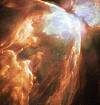
|
 |
Spying the surface of Titan
April
25: New images of unsurpassed clarity have been obtained with
the European Southern Observatory's Very Large Telescope of formations on the
surface of Titan, the largest moon in the Saturnian system.
 FULL STORY FULL STORY
 |  |

|
 |
Four ways to see Saturn
April
24: A montage of Cassini images, taken in four different regions
of the spectrum from ultraviolet to near-infrared, demonstrates that there is
more to Saturn than meets the eye. Cassini is two months away from entering orbit
around Saturn.
 FULL STORY FULL STORY
 |  |
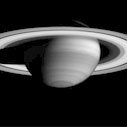
|
 |
Researcher predicts Jupiter spots will disappear
April
23: If a University of California, Berkeley, physicist's vision
of Jupiter is correct, the giant planet will be in for a major global temperature
shift over the next decade as most of its large vortices disappear.
 FULL STORY FULL STORY
 |  |

|
 |
Lure of the rings
April
22: Resembling a diamond-encrusted bracelet, a ring of brilliant
blue star clusters wraps around the yellowish nucleus of what was once a normal
spiral galaxy in this new image from NASA's Hubble Space Telescope.
 FULL STORY FULL STORY
 |  |

|
 |
Chandra reveals two faces of supernova power
April
21: The Chandra X-ray Observatory has clearly shown two aspects
of the enormous power released when a massive star explodes. An implosion crushed
material into an extremely dense neutron star, triggering an explosion that sent
a shock wave rumbling through space at speeds in excess of 5 million miles per
hour.
 FULL STORY FULL STORY
 |  |

|
 |
Intermediate mass black hole mystery resolved
April
19: New research solved the mystery of how a black hole, with
the mass more than several hundreds times larger than that of our Sun, could be
formed in the nearby starburst galaxy, M82.
 FULL STORY FULL STORY
 |  |

|
 |
Comet observed crashing into distant star
April
19: Evidence that a comet-like body with a diameter of at least
100 kilometres fell into a massive, very young star has been obtained by a team
of astronomers at Penn State University using the 9.2-metre Hobby-Eberly Telescope
at the McDonald Observatory in Texas.
 FULL
STORY FULL
STORY
 |  |
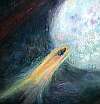
|
 |
Cassini spots Saturn moons
April
17: Cassini has sighted Prometheus and Pandora, the two F-ring-shepherding
moons whose unpredictable orbits both fascinate scientists and wreak havoc on
the ring. The moons, which were discovered in images returned by the Voyager 1
spacecraft in 1980, are in chaotic orbits that can change when the moons get very
close to each other.
 FULL STORY FULL STORY
 |  |
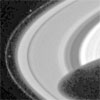
|
 |
SuperWASP begins search for thousands of new planets
April
16: April 16th saw a consortium of astronomers celebrating the
commissioning of the SuperWASP facility at the Spanish Roque de Los Muchachos
Observatory on La Palma, Canary Islands, designed to detect planets outside our
own solar system.
 FULL
STORY FULL
STORY
 |  |

|
 |
Cosmic magnifying glass reveals distant planet
April
15: Like Sherlock Holmes holding a magnifying glass to unveil
hidden clues, modern day astronomers used cosmic magnifying effects to reveal
a planet orbiting a distant star.
 FULL STORY FULL STORY
 |  |

|
 |
Hubble observes planetoid Sedna as mystery deepens
April
14: Astronomers poring over 35 Hubble Space Telescope images of
the solar system's farthest known object, unofficially named Sedna, are surprised
that the object does not appear to have a companion moon of any substantial size.
 FULL STORY FULL STORY
 READ EARLIER STORY READ EARLIER STORY
 |  |

|
 |
Invisible giants exposed in new Spitzer image
April
14: Hidden behind a curtain of dusty darkness lurks one of the
most violent pockets of star birth in our galaxy. Called DR21, this stellar nursery
is so draped in cosmic dust that it appears invisible to the human eye.
 FULL STORY FULL STORY
 |  |

|
 |
SOHO sees its 750th comet
April
11: The joint European/NASA SOHO solar observatory spacecraft
has discovered its 750th comet. The finding was made by the German amateur astronomer
Sebastian Honig, one of the most successful SOHO comet-hunters. It was a part
of the Kreutz family of "sungrazing" comets, which usually evaporate in the hot
solar atmosphere.
 FULL STORY FULL STORY
 |  |

|
 |
Cassini observes merging Saturnian storms
April
8: Merging is one of the distinct features of storms in giant
planet atmospheres. Only a month and a half into its long approach to Saturn,
the Cassini spacecraft captured two storms, each a swirling mass of clouds and
gas, in the act of coalescing during March and April.
 FULL
STORY FULL
STORY
 |  |

|
 |
Search for near-Earth asteroids heads south
April
6: The hunt for asteroids on a collision course with Earth has
been largely limited to the Northern Hemisphere. But last week astronomers took
the search for Earth-threatening asteroids to southern skies with a refurbished
telescope at the Australian National University's Siding Spring Observatory.
 FULL
STORY FULL
STORY
 |  |
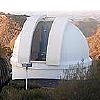
|
 |
Milky Way past was more turbulent than known
April
6: A team of astronomers from Denmark, Switzerland and Sweden
has achieved a major breakthrough in our understanding of the Milky Way, the galaxy
in which we live. After more than 1,000 nights of observations spread over 15
years, they have determined the spatial motions of more than 14,000 solar-like
stars residing in the neighbourhood of the Sun.
 FULL STORY FULL STORY
 |  |

|
 |
Saturn moon casts 'once-in-a-lifetime' shadow
April
5: A rare celestial event was captured by NASA's Chandra X-ray
Observatory as Titan — Saturn's largest moon and the only moon in the Solar
System with a thick atmosphere — crossed in front of the X-ray bright Crab
Nebula. The X-ray shadow cast by Titan allowed astronomers to make the first X-ray
measurement of the extent of its atmosphere.
 FULL STORY FULL STORY
 |  |

|
| |
New quasar studies set stringent limit
April
3: Careful analysis of new data obtained using the UVES spectrograph
on Kueyen, one of the 8.2-metre telescopes of ESO's Very Large Telescope array
at Paranal (Chile), has provided the strongest astronomical constraints to date
on a possible variation of the "fine structure constant."
 FULL STORY FULL STORY
 |  |

|
 |
Detailed VLT images of the largest moon in the solar system
April
1: A team of French astronomers has recently used the state of-the-art
NACO adaptive optics system on ESO's Very Large Telescope to map Titan by means
of near-infrared images and to search for changes in the dense atmosphere. The
newly acquired images show details of the order of 200 km and reveal new features
in the atmosphere.
 FULL
STORY FULL
STORY
 |  |
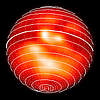
|
 |
Hunt for extrasolar Earth-like planets intensifies
April
1: An international group of astronomers are about to continue
their hunt for extrasolar planets with an enhanced world-wide telescope network
in May. They are hoping to secure firm evidence for the existence of Earth-mass
planets orbiting stars other than the Sun, which has so far eluded astronomers.
 FULL STORY FULL STORY
 |  |

|
 |
Calculating the odds of other habitable 'Earths'
April
1: More than 100 planetary systems have already been discovered
around distant stars. How many of the known exoplanetary systems might contain
habitable Earth-type planets? Perhaps half of them, according to a team using
computer modelling to calculate the likelihood of any 'Earths' existing in the
so-called habitable zone.
 FULL STORY FULL STORY
 |  |

|
 |
Dozens of 'mini-galaxies' discovered by astronomers
April
1: A new survey made with the Anglo-Australian Telescope has
revealed dozens of previously unsuspected miniature galaxies in the nearby Fornax
galaxy cluster. They belong to a class of galaxies dubbed "ultra-compact dwarfs."
 FULL STORY FULL STORY
 |  |

|
 |



